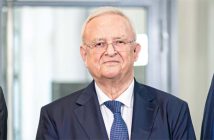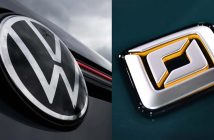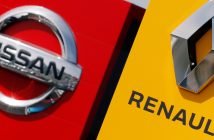+++ AUTOPILOT TAXIS are being put into trial operation on roads in Changsha, Shanghai and more places in China recently, while autopilot distributing vehicles, sanitation vehicles and police cars are being more frequently spotted as well. In Guangzhou’s Huangpu district, the starting fare for an autopilot taxi is 7.2 yuan ($1.02) while for a normal taxi, it is 12 yuan. Different from a traditional taxi, an autopilot one is mounted with sensors, including laser radars, millimeter-wave radars, cameras and GPS. A screen is mounted before the back seat of the autopilot taxi where a start button is displayed. As long as a rider presses the button, the car starts to move. A rider is informed of operation information via the screen at the back seat. On the driver’s seat, a safety supervisor is on alert with 2 hands over the wheel but without touching it, always ready to take over the driving if necessary. “In the first month when we operated autopilot taxis, we completed 8.396 orders in Huangpu district, an area spanning 144 square kilometers in southern China’s Guangzhou”, said Han Xu, founder and CEO of WeRide, an autopilot taxi operator. “The daily orders reached 271 on average and 94 % of the riders gave the experience a 5-star rating”. Compared with a taxi at a higher speed, autopilot vehicles for loading items are more mature in their application. In Futian of southern China’s Shenzhen, via 5G networks, an autopilot police vehicle is able to shoot pictures at 4K definition and transmit them back as evidence for police operations. Also, a button is prepared on the vehicle for people to call the police. Currently, more than 200 such low-speed vehicles have been under operation in the country. This year, while China is facing downward pressure on the economy, autopilot industries are gaining momentum. Large-scale financing has happened continuously for companies such as Waymo and DiDi Chuxing’s autopilot subsidiary. Data from China EV100, a think tank focusing on the EV industry, showed that in the first quarter, total financing at home and from abroad had exceeded $3.5 billion; up 34.1 % year-on-year. A McKinsey & Co report shows that China will become the largest autopilot market in the world. By 2030, sales in autopilot vehicles in China will reach $230 billion, and the order amount for mobility services based in autopilot driving will reach $260 billion. However, wide application of autopilot is closely associated with many aspects such as technology, cost, product quality, laws and regulations. From test operation to large-scale application, there is a long way to go. In the 2020 Government Work Report, AI, 5G and big data centers are considered as key areas in the country’s new infrastructure constructions. The whole autopilot industry will likely usher in a golden age as it stands at the junction of the fields mention above, insiders said. Internet giants like Baidu, Tencent and Alibaba have announced they will invest more than 100 billion yuan to facilitate smart transportation. According to Baidu’s first-quarter fiscal report, its autopilot car Apollo had won the bidding in car-to-road projects in Chongqing, Hefei and Yangquan. The company also struck cooperating deals with Nanjing and Guangzhou in new infrastructure construction. +++
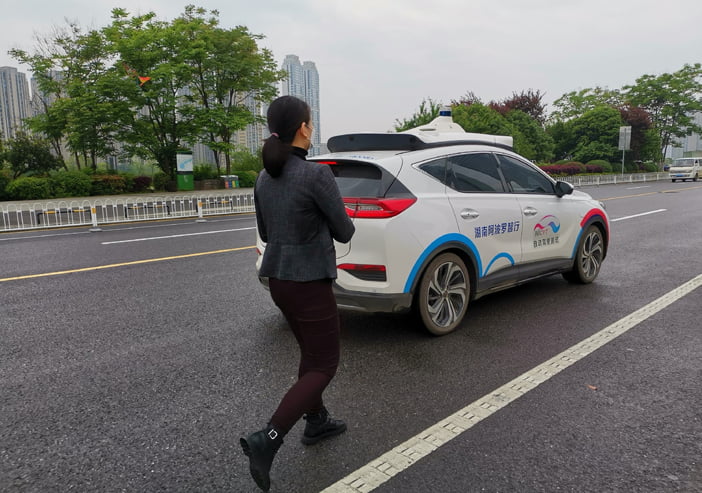
+++ BATTERY giant Contemporary Amperex Technology Ltd (CATL) said that its new super battery is ready for mass production, which according to industry experts could be a game-changer for automakers as well as the electric vehicle industry. The Chinese battery supplier, which has leading carmakers like Tesla, BMW and Daimler as clients, told that the new battery is capable of powering an electric vehicle for 2 million kilometers and will last 16 years. Current EV batteries can run for 250.000 kilometers and have a life span of 8 years at maximum. “The battery is ready for mass production and will greatly reduce the costs”, the company said. The firm said that the new technology relies on innovations to slow down the capacity decay rate and enable batteries to store more energy for longer periods. Experts said that the (2) million-mile batteries will provide a key boost to the sales of electric vehicles as battery life span has been one of the main reasons deterring consumers from purchasing EVs. “It would be game-changing if EVs become the main source of transport in the future. CATL’s supply chain firms and related automakers like Tesla will embrace continuous opportunities”, said Deng Xue, chief auto analyst from TF Securities. Though CATL did not disclose any supply contracts, it has signed a 2-year deal with Tesla to supply its Model 3 batteries. The US firm had stated earlier that it was planning a million-mile battery. The Covid-19 pandemic has suppressed the automotive market with Bloomberg New Energy Finance anticipating that global EV sales will fall by 18 % this year to 1.7 million units. During the first quarter, CATL posted a revenue of 9.031 billion yuan; down 9.53 % on a yearly basis, mainly due to the Covid-19 epidemic. “The epidemic may have a lasting effect this year, but won’t be a major factor next year”, said CATL chairman Zeng Yuqun in an interview, adding that the company has great confidence for the long run. The remarks also echo BNEF’s prediction that battery-powered vehicles will recover to account for 8.1 % of all vehicle sales next year in China. +++
+++ BMW is celebrating a new milestone in the United States, the production of its 5 millionth vehicle, which will remain at the factory and become part of the company’s historic collection. The model is an X5 M Competition, finished in Toronto Red Metallic on top of a Silverstone Full Merino leather interior, which sits on 21 inch front and 22 inch rear M Star-spoke bi-color wheels. It rolled off the assembly line at the Spartanburg plant, in South Carolina, on June 4. “You cannot be successful in business if you do not have great products and great people. This BMW X M Competition is a symbol of the success of our products and the commitment and dedication of our associates and supplier network”, said the president and CEO of BMW Manufacturing, Knudt Flor. “Every BMW X5 in the world comes from Plant Spartanburg. We are proud to call South Carolina home”. Besides the X5 M and X5 M Competition, which pack a 4.4-liter twin-turbo V8 rated at 600 ho and 625 hp respectively, the Spartanburg factory also makes the regular versions of the premium SUV. Home to more than 11.000 employees, it was expanded six times to more than 7 million square feet, with total investments of over $10.6 billion. The X3, X4, X6 and flagship X7 are also made in South Carolina. BMW celebrated its first production milestone in the U.S. back in February 2006, with the one-millionth car, a Z4 M Roadster. The 2 millionth vehicle rolled off the assembly line in January 2012 and was an X3 xDrive35i, while the 3 and 4 million cars were built in March 2015 and September 2017, and were an X5 M and an X3 xDrive40i respectively. +++
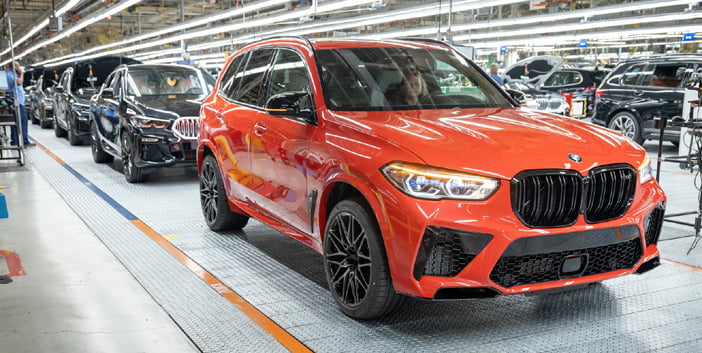
+++ CHINA ’s auto sales in May rose 14.5 % from the same month a year earlier, industry data showed, the second consecutive month of increase as the world’s biggest vehicle market recovers from lows hit during coronavirus lockdowns. The result followed a 4.4 % rise in April and a 43 % drop in March, when the pandemic pummelled demand. Before April, sales had suffered an almost 2-year slump. Sales in May rose to 2.19 million vehicles, showed data from the China Association of Automobile Manufacturers (CAAM), the country’s largest auto industry association. Government support policies and improving consumer confidence contributed the May growth, said senior CAAM official Chen Shihua during an online briefing. However, developments with the global pandemic might impact overseas demand for China-made vehicles, Chen said. In May, sales of new energy vehicles (NEVs) fell for an 11th month to 82.000 units, the data showed. NEVs include battery-powered electric, plug-in petrol-electric hybrid and hydrogen fuel-cell vehicles. Automakers including Geely, Toyota and Ford reported positive China sales in May. CAAM last month said annual auto sales could fall 15 % to 25 % due to, for instance, government restrictions on movement and business aimed at containing the novel coronavirus. The outlook indicates challenges ahead as the industry works to emerge from the prolonged slump in demand, which was also exacerbated by a trade war with the United States. Xu Haidong, another CAAM official, said the industry body now thinks China’s full-year auto sales will be better than expectations for a 15 % fall. He did not elaborate. +++
+++ A group of owners of 2011 and newer FORD MUSTANG cars is suing the company over alleged defects in the sports car’s Getrag MT82 6-speed manual transmission. The suit alleges that Ford knows of the issue but has not taken adequate steps to prevent it, despite a series of Technical Service Bulletins (TSBs) and other guidance to dealerships about various transmission problems. The TSBs address a number of issues, all related to shift quality: Grinding, higher-than-expected shift effort, delayed clutch re-engagement, and notchiness. A National Highway Traffic Safety Administration (NHTSA) investigation found there was no safety risk associated with the issues and Ford provided a few fixes that are claimed to address these complaints. But owners say it isn’t enough and that, unaddressed, the alleged underlying flaws in the Getrag design can cause “premature internal wear, increased shift efforts, inability to drive, and eventually suffers a catastrophic failure”. Ford declined to comment on the allegations. The Getrag MT82 replaced the older Tremec 3650 for the 2011 model year. When new, it was a significant upgrade in both shift quality and (more importantly) gained an entire ratio over its 5-speed predecessor. Revised for the 2018 model year, the updated MT82-D4 (which is also implicated in the lawsuit) was intended to fix some of the issues that plagued the earlier variant, with stronger synchros through 4th gear and a revised shift feel. Ford also added a twin-disc clutch and dual-mass flywheel. I found the MT82-D4 “high-friction and balky” in use, receiving nearly unanimous criticism from other people. The lawsuit, filed in California, will be heard in the United States District Court for the Eastern District of Michigan. +++
+++ Major auto parts supplier Visteon forecasts GLOBAL PRODUCTION VOLUMES for the auto industry to fall between 20 % and 25 % this year and warned it would be a couple of years before they returned to 2019 levels. The U.S. auto industry has been struggling to recover after the coronavirus pandemic shutdown factories and disrupted global supply chains for 2 months. “Even before Covid-19, the auto industry was slowing down globally and most notably in China and Covid-19 has dealt a significant blow, pushing the industry to levels that have not been seen in a long time”, Visteon chief executive officer Sachin Lawand said. IHS, which closely tracks automotive sales and production trends, has forecast global light vehicle sales to fall 22 % to 70.3 million units in 2020, from its prior estimates of a more than 12 % drop. However, Lawand said China has now rebounded, with Visteon, a key supplier to General Motors and Ford, at almost pre-Covid production levels in China. The automotive industry in the United States has been ramping up after the pandemic-driven shutdown, and major automakers have been keeping a close eye on suppliers in Mexico to ensure the pandemic does not disrupt the flow of auto parts. Yet another supplier BorgWarner said its plants in North America and Europe have been running for almost a month, but flagged volatility in production schedules for OEMs. Detroit automakers resumed production in the United States on May 18, and Mexico’s export-focused auto industry has been slowly reopening under pressure from its top trade partner, the United States. +++
+++ HONDA has formed a research and development joint venture for connected vehicles together with a Chinese firm in a bid to accelerate future mobility services in the world’s largest automotive market. Honda said its wholly owned subsidiary, Honda Motor China Investment and Neusoft Reach Automotive Technology Shanghai had established Hynex Mobility Service Co. in Dalian. The new business will start operations on July 1. Neusoft Reach is an automotive unit of Neusoft Corp., a major Chinese information technology firm. The Japanese automaker aims to advance Honda Connect, its onboard connected system, to customize it for individual drivers through the use of artificial intelligence technology and big data analysis in the Chinese market, a Honda spokesman in Tokyo said. Hynex Mobility, capitalized at 300 million yuan (¥4.5 billion), is 51 % owned by the Honda subsidiary with the remaining 49 % by the Chinese partner, Honda said in a statement. +++
+++ It’s possible the new HONDA CIVIC TYPE R won’t be a hybrid after all, despite recent reports to the contrary. Even though it doesn’t seem like the current FK8 Civic Type R was launched all that long ago, a new-generation model is in the works and was recently spied testing. When those spy shots surfaced, it was claimed the hot hatch would continue to use a turbocharged 2.0-liter 4-cylinder to power the front wheels but also feature 2 electric motors driving the rear wheels. Autointernationaal.nl recently reached out to senior vice president at Honda Europe, Tom Gardener, for clarification on the Type R’s powertrain and was told “no decision” has been made on what will power the hatchback. “We have our main pillars that are going to be electrified. Clearly we have a very famous product, such as the derivative of the Civic, which I guess is what you are referring to in the Type R, but no decisions have been made on that yet”, Gardener said. “We’re very much aware of customers’ strong appreciation of the current model, and we’ll have to deeply consider the best progress forward”. While this statement can be taken to mean the new Type R will not be a hybrid, Gardener’s lack of confirmation either way still leaves us with the possibility the car will adopt some form of electrification. Given that testing of the car has already started, it’s also clear the Japanese automaker likely has decided on its powertrain, even though it may not be ready to tell the world. Whatever powertrain the car ends up using, I know the new Civic Type R will grow in size and feature a longer wheelbase than the current model. +++
+++ HYUNDAI is readying a family of radical electric cars, all built on the Korean firm’s new modular EV platform and each with very different styling. First will be a production version of the retro-styled 45 concept in 2021, followed soon after by the production version of the sleek Prophecy concept. The third vehicle will be shown next year as a concept and is said to demonstrate the breadth of the Electric Global Modular Platform (E-GMP). SangYup Lee, Hyundai’s head of design, said: “The new EV architecture gives us a long wheelbase and a flat floor, and we’re experimenting with unique USPs and how we will stretch it for various vehicles. “The 45 is more SUV-style and the Prophecy is the future saloon proposal. The third one is more of the space concept: the big one”. The 45 will sit above the Kona Electric as Hyundai’s first stand-alone electric model. Lee confirmed that the design of the production car (which was recently spotted testing at the Nürburgring) is finished and closely reflects the 1970s-style concept shown last September. “The show car is a very serious concept”, said Lee. “It’s not a concept that’s never going to make production. That’s how we like to start. I’m quite happy how close the production version is to the show car, and the same thing applies for the Prophecy, too”. The Prophecy, whose design is currently being finalised, will be a performance-led rival to the Tesla Model 3. Inspired by 1930s streamliners, it looks totally different to the 45. This move is a result of Hyundai’s desire to avoid the Russian-doll approach taken by so many brands. Lee commented: “It’s about unexpectedness. Our design philosophy begins with sensuous sportiness. Hyundai is known for value for money, but this isn’t enough. Sensuous sportiness adds a lot more emotional value to the vehicle. People have different lifestyles, and we want to have design tailored to those different lifestyles. Looking at the 45 and Prophecy shows our design spectrum”. Consistency across the Hyundai range will be achieved through finer design details. Lee explained: “The typical thing is to have the same grille or headlamp shape. This isn’t where we want to create brand consistency. We want to create it in the details, for example, light details. When you look at the 45 and Prophecy, they both have pixel lamps, a series of tiny LEDs which can be animated”. Hyundai intends to launch 16 new EVs by 2025 to increase its annual EV sales to more than half a million; the equivalent of just over 10% of its total sales in 2019. The brand currently offers 2 electric vehicles: the Kona Electric and the Ioniq Electric. +++
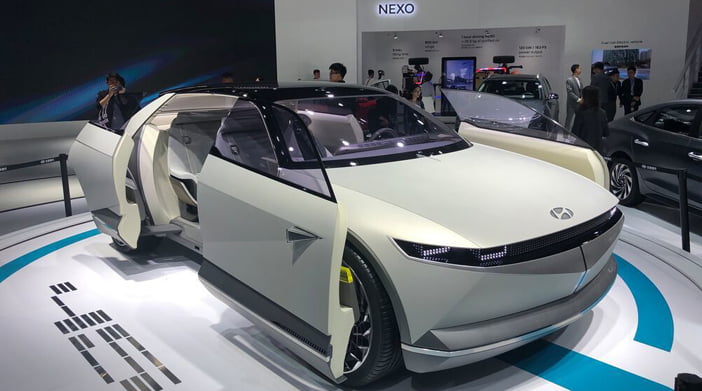
+++ KIA halted production at its 2 domestic plants on Thursday, as 2 workers at the plants near the capital were confirmed to have contracted the new coronavirus. The suspension came after 2 workers at the plants in Gwangmyeong, Gyeonggi, tested positive for Covid-19. Korean health officials tested workers who came into contact with the virus patients. The test results are due as early as Friday morning. Kia and health officials carried out disinfection work at the 2 plants, including a fitness center used by a coronavirus patient, in a precautionary move to stem the spread of the virus. Around 6.000 people work at the plant. The company said it remains unclear how long the suspension will last. The suspension disrupted production of about 1.300 vehicles, according to Kia. The No. 1 plant churns out the Carnival, the Stinger and the flagship K9 sedan, while the No. 2 plant produces the Rio and the Stonic. Kia has 8 plants in South Korea: 2 in Gwangmyeong, 3 in Hwaseong and 3 in Gwangju and 7 overseas (3 in China and 1 each in the United States, Slovakia, Mexico and India). Their overall capacity is 3.84 million units. +++
+++ Earlier this week, it was reported that EU antitrust regulators were concerned regarding Fiat Chrysler Automobiles (FCA) and PSA’s combined high market share in small vans, and were expecting the 2 carmakers to address these concerns in a matter of days. It seems that neither brand managed to do so, and now an expedited process might be out of the question. Going forward, the European Commission will likely open a so-called Phase Two investigation that would delay the concessions deadline until October. The 2 companies are still planning on completing their MERGER during the first quarter of next year. FCA and PSA decided to merge back in December and have kept those hopes alive despite the ongoing coronavirus pandemic and the disruption it has caused within the industry. It’s also unclear how the EU will take into account the plummeting demand for new cars in the region due to the pandemic. “Regulatory approval of FCA – PSA’s tie-up is still likely, given potential antitrust concerns are small compared with the deal’s size”, said Bloomberg Intelligence analyst Aitor Ortiz. “They may be addressed with remedies. These concerns should send the deal to a phase-two review”. Even though the companies were told that their combined high market share in small vans was what worried competition enforcers, Ortiz claims that their most problematic overlaps may be in minicars and small SUVs, where their combined market share could reach roughly 65 percent. However, based on data from the PSA – Opel deal of 2017, there should still be sufficient competition in most passenger car segments from the likes of the VW Group, Renault, Nissan, Hyundai, Kia, Mazda and Toyota. +++
+++ The new NISSAN Qashqai has been spied testing in prototype form for the first time ahead of its planned unveiling later this year. The third generation of the hugely popular crossover is due to go on sale next year, and it’s set to continue being built at the Japanese firm’s plant in Sunderland. With Nissan planning to trim much of its European model line as part of a cost-cutting restructuring, the new Qashqai will be of vital importance to the firm. It sold more than 230.000 examples of the model across Europe in 2018 and it was the fifth bestselling car in the United Kingdom last year, despite its age and increasing competition in its class. Photographers captured 3 prototype versions of the new Qashqai being put through their paces at a test facility. While the machines sported camouflage wrap, the photographs suggest that the new Qashqai will retain broadly familiar styling, albeit updated with the more angular styling of Nissan’s current design language seen on the recently unveiled new Juke. The front of the car also looks to be slightly lower than on the previous model. The new Qashqai will continue to use the Renault – Nissan – Mitsubishi alliance’s CMF platform, which is also used for the Renault Kadjar and the larger Nissan X-Trail. While unconfirmed, it’s expected that Nissan won’t offer any diesel engines for the new model, but will offer an expanded range of electrified powertrains, ranging from 48 Volt mild hybrid options to a plug-in hybrid powertrain based on that of the Mitsubishi Outlander PHEV. It is unlikely that the new Qashqai will be offered in full electric form, with Nissan currently developing a bespoke electric SUV on the alliance’s new CMF-EV platform, the Ariya. The interior of the car is also expected to be given a radical revamp, with an overhauled infotainment system and new dashboard design. Under the recent alliance revamp, the 3 firms will move to a leader-follower, with Nissan taking the lead on development of CMF-platform cars. There are also talks to switch production of the similar Kadjar to Sunderland. The Qashqai is one of Nissan’s key global models and is offered in all the firm’s key markets, although it’s branded as the Rogue Sport in the US. +++
+++ It’s no secret PORSCHE is working on a wagon variant of its battery-electric Taycan sportsedan. When the German brand plans to unveil the long-roof Taycan model officially remains a mystery. Thanks to a well-placed source within the company, though, I now have a general idea of the forthcoming Taycan Cross Turismo’s unveil date, and it’s sooner than we expected. While I do not know an exact day or time, I was told the Taycan stationwagon will officially debut toward the end of the year. Frankly, I figured Porsche would wait until 2021 to show off the model. Nevertheless, the fact the brand plans to take the wraps off of the Taycan Cross Turismo before the calendar turns over, gives us hope the car will reach our showrooms by the middle of 2021. The Taycan Cross Turismo will marry the basic shape of the Mission E Cross Turismo concept with the bodywork of the production Taycan sedan. As such, don’t expect certain elements from the concept car, such as its hood-mounted fog lights to see the light of day. Other pieces, though, like the raised ride height and chunky fender flares, are sure to appear on the production Cross Turismo. Additionally, I believe Porsche will also sell a less off-road-oriented Taycan Sport Turismo, similar to the Panamera wagon variant by the same name. Regardless, expect the electric hauler to carry over the all-wheeldrive Taycan 4S and Turbo sedans’ powertrains, the former of which features 2 motors that put out a combined maximum 522 hp with the standard 79 kWh battery pack and 562 hp with the optional 93 kWh pack. The Turbo, meanwhile, offers as much as 670 hp and comes exclusively with the bigger battery. Driving range for the Cross Turismo ought to fall a few kilometres to its sedan counterparts. Alas, I do not expect the 750 hp powertrain of the Taycan Turbo S to make its way to the Cross Turismo. That said, we’re certain to know more about the Taycan Cross Turismo’s powertrain and other details by year’s end. Who knows? Maybe Porsche will surprise us with a Taycan Cross Turismo Turbo S, too. +++
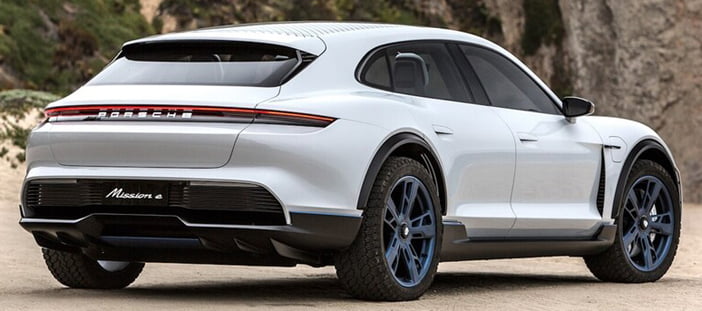
+++ The PSA GROUP , which has the ability to offer its C-segment family cars in either plug-in hybrid or battery-electric form, is leaving individual brands to decide which is best, according to its director of low-emission vehicles, Anne-Lise Richard. “The C-segment is really in the middle”, Richard told. “It can have many profiles: sometimes it’s the only car in the household, sometimes not. Currently, both EVs and plug-in hybrids are suited to the segment and could find customers”. To date, new small cars from PSA, such as the DS 3 Crossback, Peugeot 208 and Opel Corsa, have offered an electric option. Larger models come with a plug-in hybrid powertrain instead, for example, the DS 7 Crossback, Peugeot 3008 and Opel Grandland X. Cars straddling these 2 sectors, such as the next Peugeot 308, have a less rigidly defined strategy. Richard said: “Inside PSA, the C-segment cars can be produced in 2 platforms, either eCMP or EMP2, so those brands could have the choice of going full-electric or plug-in hybrid. It’s more of a brand decision to choose which is the best one”. Richard revealed a future intent to adapt the EMP2 platform to underpin EVs but said PSA “will look at what customers say and how the environment evolves before making those changes”. The next-generation Peugeot 308 will arrive in 2022 and sit on an updated version of the current EMP2 platform. The Ford Focus rival will offer 2 plug-in hybrid options: an economy-minded front-wheeldrive model and a more performance-focused 4-wheeldrive car with 360 hp. However, Citroën will go electric (but still offer petrol and diesel engines) with its new CMP-based C-segment car, a replacement for the C4 and C4 Cactus that’s due to be unveiled in the coming weeks. The similar-size Opel Astra and DS 4 will take the same route as the Peugeot for its next generation. Richard also admitted “there’s room for smaller cars (A-segment models) to be electrified”, but said the decision on making a new Peugeot 108 has yet to be made, acknowledging that it would be “really difficult to define the right balance between range and price”. Peugeot considered offering a cheaper, lower-range variant of the e-208, but Richard said the firm saw that “customers need to be convinced that they have enough range, and we wanted to go with range that could take away the barrier to buying an electric car”. +++
+++ A further investment by the French government in RENAULT ’s capital would not be the most pertinent or useful use of state resources, the carmaker’s chairman said, adding that nationalisation of the firm was not being contemplated. “I’ve said that it isn’t on the table”, Jean-Dominique Senard told a hearing in the lower house of the French parliament. “I have nothing against the state, I’m just saying that it’s not useful to spend taxpayer money to invest it in a company which needs to find its own resources”. Renault is 15 % owned by the French government. It tapped state aid to help cope with the coronavirus pandemic via a €5 billion state-guaranteed loan. Renault’s partnership with Nissan has entered an “incredibly positive” phase after episodes of strained relations in recent years, the French carmaker’s chairman Jean-Dominique Senard said. “We’ve put the work in, we’re in an incredibly positive dynamic”, Senard told a hearing in France’s lower house of parliament, after Renault and Nissan presented plans to deepen their collaboration in May. Senard added that Renault was confident that car sales, which have ground to a halt during the coronavirus pandemic and ensuing lockdowns, would pick up again in France in the coming months. +++
+++ Electric truck startup RIVIAN scored yet another rising star from the Detroit auto industry establishment with the addition of former GM engineer Alex Archer, the company has confirmed. Archer will start her new role as a design and release engineer later in June. Archer generated buzz for designing the power-sliding center console in GM’s new full-sized SUVs. Archer, just 2 years out of Stanford University with a degree in engineering and product design, was then just 24. The project took 9 months of engineering work and another 6 for approval of the prototype console. “We are always looking for talent that performs best in the tension between the excitement of building something new and the important learning that comes from established products and processes”, Rivian chief people officer Helen Russell told. “We’re excited to have people like Alex coming on board because they represent the best of that balance”. Rivian says it remains in “growth mode” despite recent setbacks, including the termination of a project that would have seen its platform underpin a new electric Lincoln SUV as part of a larger partnership with Ford. While the partnership itself remains intact (and was cemented by the addition of Ford family member Alexandra English to the Rivian board), Rivian was forced to cut 40 jobs in the wake of that and other coronavirus-related setbacks. Rivian spokeswoman Amy Mast confirmed the number but told the company remains healthy and focused on launching its products. “From time to time, it’s important for any performance-focused and fast-growing company to streamline its organization to improve effectiveness”, she said. “We made recent changes that impacted around 40 employees”. +++
+++ SKODA has released details of new technology designed to prevent drivers opening doors into cyclists. The new ‘Exit Warning’ system will debut on some versions of the new Octavia, which has already gone on sale. Fitted as part of the blind-spot detection system, which notifies the driver if there is a vehicle in the blind spots over their shoulders, Exit Warning will come as standard on Octavias in First Edition trim. That is currently the top-of-the-line model, but the technology will also come as standard on more luxurious models when they arrive in the family car’s range. The technology uses sensors capable of ‘seeing’ up to 35 metres from the rear of the vehicle, with a 120-degree field of view. The system can then alert drivers or front-seat passengers to the presence of a cyclist using a series of visual and aural warnings, which will continue until the hazard has passed. Skoda hopes the technology will reduce the prevalence of “dooring”, where cyclists are hit by the door of a parked vehicle opened by a passenger or driver. Exit Warning sits alongside the Octavia’s more familiar arsenal of cyclist protection systems, including Predictive Cycling Protection, which triggers warnings if a cyclist is detected up ahead. The system can even slam on the brakes if it decides action is necessary to avoid a collision. More innovative additions include the new Turn Assist system, which is seeing service in a Skoda for the first time ever. With the help of on-board cameras, the system can monitor oncoming traffic (including cyclists and pedestrians) when turning right at junctions. If danger is detected, the vehicle will be stopped automatically, triggering the warning signals to help prevent a possible collision. The new Octavia is also fitted with the new-to-Skoda Collision Avoidance Assist system, which can detect an impending collision and manoeuvre the car around the hazard, whether it is a cyclist or vehicle. The system uses real-time data provided by the camera array and radars to calculate the most appropriate and safest route around the potential danger. “The all-new 4th generation Octavia is the most technologically advanced Skoda yet and one of the most cycle-friendly cars on the market”, said a spokesperson for the brand. “Naturally, cyclists face daily challenges associated with cycling on busy roads, including avoiding car doors as they open. The technology introduced in the new Octavia, particularly Exit Warning, is there to assist drivers in helping to mitigate and reduce potential accidents”. +++
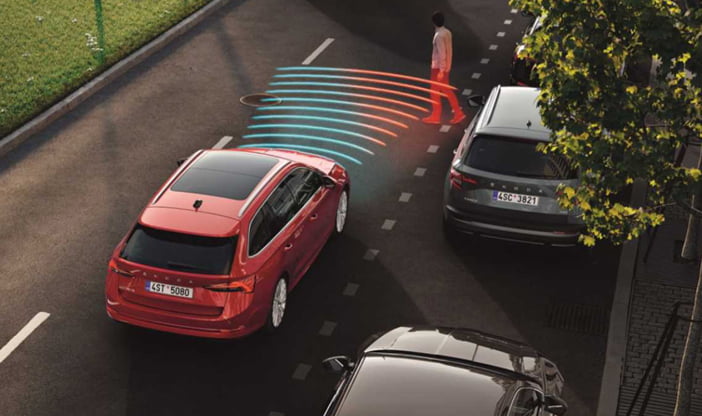
+++ TESLA has received government approval to build Model 3 vehicles in China equipped with lithium iron phosphate (LFP) batteries, a document on Ministry of Industry and Information Technology website showed. It was reported in February that Tesla was in advanced talks to use LFP batteries from CATL that contain no cobalt (one of the most expensive metals in electric vehicle (EV) batteries) in cars made at its plant in China. The document does not provide the name of the battery maker. Tesla did not immediately respond to a request for comment. +++
+++ TOYOTA boss Akio Toyoda assured shareholders that the auto giant will stay in the black for the current business year even if the coronavirus crisis “exceeds the Lehman shock”, thanks to years of cost-cutting efforts. “We can secure operating profit” in fiscal 2020, which runs through next March, Toyoda told shareholders during their annual general meeting at the carmaker’s headquarters in Aichi Prefecture. “Undoubtedly Toyota has become stronger”, he said. Last month, the firm expected its group operating profit to fall nearly 80 % from the previous year to ¥500 billion ($4.7 billion), the lowest in 9 years. But it also said rigorous cost reductions would help ease the impact from the pandemic on global sales. The automaker has refrained from cutting any jobs. Instead it says it will reduce costs by scrutinizing and improving every aspect of its business. Around 360 shareholders took part in Thursday’s meeting, considerably fewer than the record 5.546 seen last year. The company had asked stakeholders to vote via the internet or by mail, and refrain from attending the gathering to prevent the spread of infection. +++
+++ “I’m sorry” is well embedded in VOLKSWAGEN ’s vocabulary, with the company having apologized a lot over these past few years, whether it was for the infamous Dieselgate scandal, making Nazi-like remarks or accusing board members of leaking confidential information. The latest apologies from the Wolfsburg brand came in the light of a racist Golf ad, launched on social media a few weeks ago and pulled down recently. The short video promoted the new-generation compact hatchback in a very questionable manner (by using black people as puppets) and went on to spark a lot of criticism. Rather than sweeping it under the mat, Volkswagen has taken action to prevent such things from happening in the future. Thus, they will improve the process of approval of new ads, boost training on ethics and culture, ensure heterogeneity and diversify their teams, and create a horizontal social media organization for enhanced response and control. “On behalf of the Board of Management, I want to formally apologize for offending people as a result of a lack of intercultural sensitivity. This was a violation of values for which Volkswagen stands”, said Hiltrud D. Werner, member of the VW Group Board or Management responsible for Integrity and Legal Affairs. “We can state that racist intentions did not play any role whatsoever. We found a lack of sensitivity and procedural errors (after analyzing around 400 files with a volume of more than 16.5 GB and conducting internal interviews with employees and the external agencies involved). And we are now taking targeted steps in response”, she added. The company’s chief marketing officer, Jochen Sengpiehl, said: “The critical point is that we failed to spot the racist elements of this video. I want to apologize for this error of judgement, also on behalf of the team. A key finding of the investigation is that we need an out-of-context review. Each clip must be unequivocal and non-critical, even without the general context. I will personally make sure that the actions resolved will be implemented in day-to-day business operations”. “I again wish to apologize to everyone whose feelings have been hurt by this thoughtless spot. That was a wake-up call. It’s our duty to fight racism every day”, commented Jurgen Stackmann, member of the Volkswagen Passenger Cars Board of Management for Sales, Marketing and After Sales. +++

